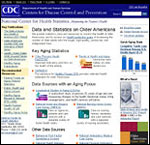CDC Features
Current Features
Learn More about Aging on the New Data and Statistics Web Site

Issues related to aging Americans are increasingly important and will continue to be a factor in our nation's health. CDC's new Aging Data and Statistics Web page brings together many information sources on the health of the growing population of older adults in the United States with the aim of improving accessibility to information to guide actions and policies to improve the health of all Americans.
Today there are over 37 million people age 65 and over, and that number is expected to rise to more than 70 million by 20301.
Current statistics reveal that Americans are living longer than ever before. In 1900, life expectancy was approximately 47 years. Americans born in 2007 can expect to live, on average, to age 78. Among people who survive to age 65, the average woman lives another 20 years while the average man lives an additional 17 years.
 CDC's new Aging Data and Statistics Web page
CDC's new Aging Data and Statistics Web page
Death rates from cardiovascular diseases continue to decline. In 2004, the death rate for heart disease was 1,418 per 100,000 population age 65 years and older compared with 2,547 per 100,000 in 1981. Causes of death that have increased in the past 20 years include diabetes, chronic lower respiratory disease, and Alzheimer's disease.
Many older Americans live with chronic diseases. In 2005 nearly half of people 65 and older reported being diagnosed with arthritis and with hypertension. The prevalence of diabetes has increased among older people from 18 percent in 1988–94 to 25 percent in 2001–2004.
Health and health behaviors vary by state. In 2006, 76 percent of older people in Colorado reported receiving an annual flu shot compared with 58 percent in Nevada.
Sixty-nine percent of people age 50 and older in Rhode Island reported having ever had a sigmoidoscopy or colonoscopy compared with 50 percent in Louisiana.
For additional information, see Aging Data and Statistics.
1Centers for Disease Control and Prevention. Behavioral Risk Factor Surveillance System— United States, 2005 [Online]. (2006). National Center for Chronic Disease Prevention and Health Promotion (producer). Available from http://apps.nccd.cdc.gov/brfss/index.asp [Cited 2007 Jun 14].
Page last updated: July 5, 2007
Content source: National Center for Health Statistics and National Center for Chronic Diseases and Health Promotion
Content owner: National Center for Health Marketing
URL for this page: www.cdc.gov/Features/Aging

